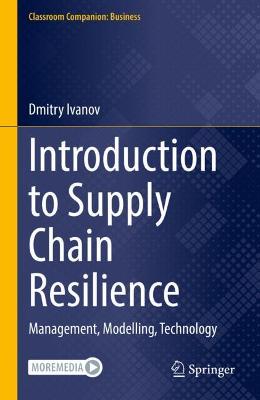Classroom Companion: Business
2 total works
This book offers a concise yet comprehensive introduction to supply chain resilience, covering management, modeling and technology perspectives. Designed to accompany the textbook “Global Supply Chain and Operations Management” it addresses the topics of supply chain risks and resilience in more depth, describing the major features of supply chain resilience and explaining methodologies to mitigate supply chain disruptions and recover. Numerous practical examples and short case studies are provided to illustrate theoretical concepts. Without relying heavily on mathematical derivations, the book explains major concepts and methods to build and improve supply chain resilience and tackle supply chain disruption risks in a simple, uniform format to make it easy to understand for students and professionals with both management and engineering backgrounds. Graduate/PhD students and supply chain professionals alike will benefit from the structured, didactically oriented and concise presentation of the concepts, principles and methods of supply chain resilience management, modeling, and technological implementation.
The book offers a concise yet comprehensive introduction to supply chain analytics covering management, modeling, and technology perspectives. Designed to accompany the textbook “Global Supply Chain and Operations Management”, it addresses the topics of supply chain analytics in more depth.
The book describes descriptive, predictive, and prescriptive supply chain analytics explaining methodologies, illustrating method applications with the use of training exercises, and providing numerous examples in AnyLogic and anyLogistix software. Throughout the book, numerous practical examples and short case studies are given to illustrate theoretical concepts. Along with AnyLogic and anyLogistix model development guidelines and examples, the book has two other distinct features. First, it reviews and explains novel frameworks and concepts related to data-driven decision-making and digital twins. Second, it shows how to use analytics to improve supply chain resilience.
Without relying heavily on mathematical derivations, the book offers a structured presentation and explanation of major supply chain analytics techniques and principles in a simple, predictable format to make it easy to understand for students and professionals with both management and engineering backgrounds. Graduate/Ph.D. students and supply chain professionals alike would benefit from a structured and didactically-oriented concise presentation of the concepts, principles, and methods of supply chain analytics. Providing graduate students and supply chain managers with working knowledge of basic and advanced supply chain analytics, this book contributes to improving knowledge-awareness of decision-making in increasingly data-driven and digital environments. The book is supplemented by a companion website offering interactive exercises with the use of AnyLogic and anyLogistix software as well as Spreadsheet Modeling.

